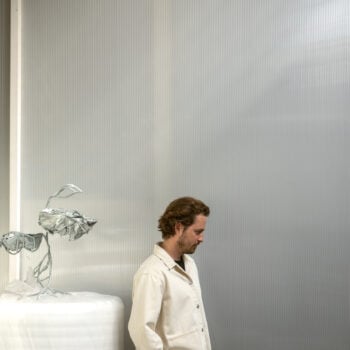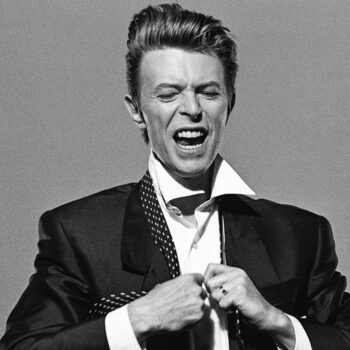Όταν ο street artist Cacao Rocks –κατά κόσµον Ιάσονας Μέγκουλας– έγραψε το 2010 σε έναν τοίχο «Athens is the new Berlin» (Η Αθήνα είναι το νέο Βερολίνο), µάλλον εξέφραζε κάποιον ευσεβή πόθο, παρά µια πραγµατικότητα. Η παρατεταµένη οικονοµική κρίση στην Ελλάδα δεν έδωσε πολλές ευκαιρίες στον ίδιο όταν τελείωσε το πανεπιστήµιο. Αντί να γίνει καθηγητής Γαλλικών, λοιπόν, στράφηκε στην τέχνη του δρόµου, αρχικά κάνοντας tagging στα όλο και περισσότερα ρηµαγµένα καταστήµατα και συνεχίζοντας µε murals και statements σχετικά µε το µεγάλο ποσοστό ανεργίας στη χώρα. Ο καλλιτεχνικός κόσµος της Αθήνας ήταν τότε σχεδόν «παγωµένος». Επτά χρόνια αργότερα, η καλλιτεχνική σκηνή της πρωτεύουσας άρχισε να ανθίζει. Το 2017 η Αθήνα κηρύχθηκε ανεπίσηµα ως η πιο καινούργια καλλιτεχνική πρωτεύουσα της Ευρώπης από την Documenta 14 –την πρώτη που διοργανώθηκε εκτός του Κάσελ της Γερµανίας– µε τίτλο Μαθαίνοντας απ’ την Αθήνα. Χρειάστηκαν µόνο 54 βαµµένα µπλε πρόβατα για να κάνει η έκθεση γνωστή την καλλιτεχνική σκηνή της πόλης σε ολόκληρο τον κόσµο!
Ωστόσο, η ανάδειξη της Αθήνας ως παγκόσµιας καλλιτεχνικής πρωτεύουσας είχε ξεκινήσει πολύ νωρίτερα. Ο µη κερδοσκοπικός Οργανισµός Πολιτισµού και Ανάπτυξης ΝΕΟΝ, µε ιδρυτή τον ∆ηµήτρη ∆ασκαλόπουλο, άρχισε να καθιερώνει την πόλη ως επίκεντρο της σύγχρονης τέχνης ήδη από το 2013, συνδυάζοντας την αρχιτεκτονική αποκατάστασή της µε την πολιτισµική ανάπτυξη. Από τις εκθέσεις που έχουν ξεχωρίσει έκτοτε είναι η Breaking News (2017), σε συνεργασία µε τον Βρετανό καλλιτέχνη Michael Landy, και οι 29 γλυπτές ανθρώπινες µορφές από σίδηρο του Sir Antony Gormley στη ∆ήλο (2019). Και οι δύο κέντρισαν το ενδιαφέρον της διεθνούς καλλιτεχνικής σκηνής. Πλέον, δεν είναι λίγοι οι καλλιτέχνες που έχουν µετακοµίσει µόνιµα στην Αθήνα, συµπεριλαµβανοµένου του Landy, ο οποίος είναι πια κάτοικος Εξαρχείων.

Η ιδρύτρια και υπεύθυνη της γκαλερί Rodeo, Σύλβια Κούβαλη, µοιράζει τον χρόνο της ανάµεσα στην ελληνική και τη βρετανική πρωτεύουσα. Ενώ δεν εκπροσωπεί αποκλειστικά Έλληνες καλλιτέχνες, λέει ότι «Έχουµε µεγάλη ευθύνη για την τοπική κοινότητα εδώ, στην Αθήνα», βοηθώντας τους να κινηθούν στην παγκόσµια σκηνή. Με την υποστήριξή της, η Χάρις Επαµεινώνδα κέρδισε τον Αργυρό Λέοντα στην Biennale της Βενετίας, ενώ ο Duncan Campbell το βραβείο Turner του Ηνωµένου Βασιλείου. Σηµαντικό µέρος του τελευταίου χρόνου η Κούβαλη το έχει περάσει στην Αθήνα, γεγονός που της επέτρεψε να επιστρέψει στις ρίζες της. «Αυτό το διάστηµα επέτρεψε σε όλους µας να κάνουµε πράγµατα που δεν µπορούσαµε όταν ταξιδεύαµε συνέχεια», λέει. Όπως το να συναντάµε τους γείτονες στο café της γωνίας ή το να βλέπουµε φίλους σε εξωτερικούς χώρους και να ανταλλάσσουµε ιδέες.
Αυτό που καταφέρνει ο καλλιτεχνικός κόσµος της Αθήνας είναι να βρει την ισορροπία ανάµεσα στο παγκόσµιο και το τοπικό, την ώρα που οι υπόλοιποι κλείνονται στον εαυτό τους. Η καλλιτεχνική διευθύντρια της Art Athina, Σταµατία ∆ηµητρακοπούλου, η οποία επέστρεψε στην Ελλάδα από το Λος Άντζελες για να αναλάβει την έκθεση, πιστεύει πως υπάρχει η δυνατότητα να αγγίξει ένα µεγαλύτερο κοινό διαδικτυακά. «Οι καλλιτέχνες και οι γκαλερί µπορούν να πειραµατιστούν», τονίζει και µε αφορµή την πρώτη ψηφιακή διοργάνωση της Art Athina τον περασµένο Οκτώβριο εξηγεί πως τόσο οι καλλιτέχνες όσο και οι επιµελητές πρέπει να κάνουν ένα δηµιουργικό άλµα προκειµένου να οραµατιστούν ότι βρίσκονται στον χώρο της έκθεσης. «Οι νεότεροι σκέφτονται πρώτα τη διαδικτυακή παρουσία και µετά τη φυσική, ενώ είναι άρρηκτα συνδεδεµένες», τονίζει.

Η Αθήνα δεν είναι µια προβλέψιµη πόλη, αλλά γεµάτη αντιθέσεις. Σε αυτή συνυπάρχουν το σύγχρονο µε το αρχαίο, το ευρωπαϊκό µε το καθαρά ελληνικό στοιχείο. Το κλίµα παίζει σηµαντικό ρόλο στην ιστορική της πορεία. Συγκρίνοντας τον καιρό στο Λονδίνο την ίδια ηµέρα (2 βαθµοί και βροχή) και στην Αθήνα (26 βαθµοί και ηλιοφάνεια), η Χλόη Βαΐτσου, διεθνής διευθύντρια της Art Dubai, σηµειώνει ότι η εγγύτητά της τόσο µε την Ευρώπη όσο και µε πρωτεύουσες της Ανατολής, όπως η Βηρυτός και το Κάιρο, της δίνει µια άλλη δυναµική, καθώς και τη δυνατότητα να χτίζει καλύτερα δίκτυα συνεργασίας και ανταλλαγής µεταξύ των πολιτισµών.
Μετά από έναν χρόνο πανδηµίας, η Αθήνα δείχνει να αντέχει περισσότερο από άλλες πόλεις, έστω και διαδικτυακά. Η διευθύντρια του οργανισµού ΝΕΟΝ, Ελίνα Κουντούρη, αναγνωρίζει πως, ενώ οι ψηφιακές πλατφόρµες κερδίζουν έδαφος, η τέχνη είναι κάτι που πρέπει κάποιος να βιώσει διά ζώσης. Είναι σίγουρη πως οι καλλιτέχνες θα παραµείνουν ευρηµατικοί και «θα συνεχίσουν να αντέχουν και να οραµατίζονται ένα µέλλον στο οποίο ο πολιτισµός θα ξεπερνά τον ψηφιακό κόσµο και θα βρίσκεται εκεί όπου ανήκει: ανάµεσά µας». Η επερχόµενη έκθεση Πύλη κάνει ακριβώς αυτό. Θα φιλοξενηθεί σε ένα ανακαινισµένο καπνεργοστάσιο, µε 40 καλλιτέχνες από την Ελλάδα και το εξωτερικό, µεταξύ των οποίων οι Michael Rakowitz, Glenn Ligon, Danh V και Μαρία Λοϊζίδου.

Η Χλόη Βαΐτσου συµφωνεί πως η ψηφιοποίηση των εκθέσεων κρίθηκε απαραίτητη και έχει σηµειώσει ορισµένες επιτυχίες, ωστόσο «Από όλους µας λείπει το να βλέπουµε ο ένας τον άλλο και να θαυµάζουµε την τέχνη. Η ψηφιοποίηση εκδηµοκρατίζει τον καλλιτεχνικό κόσµο, αλλά ταυτόχρονα φέρνει έναν υπερκορεσµό του ψηφιακού περιεχοµένου». Συµπληρώνει ότι η επιτυχία µιας έκθεσης δεν αποτυπώνεται σε αγορές. «Το να βιώνει κανείς την τέχνη από κοντά είναι µια ενστικτώδης εµπειρία».
Η φετινή θα ήταν µια σπουδαία χρονιά για την Αθήνα, καθώς είναι η 200ή επέτειος από την Ελληνική Επανάσταση. Ωστόσο, διατηρούνται χαµηλοί τόνοι, ενώ πολλές εκδηλώσεις αναβλήθηκαν λόγω της πανδηµίας. Η Σύλβια Κούβαλη προβλέπει πως πολλές εκθέσεις θα µεταφερθούν για το καλοκαίρι. Όπως συνέβη πέρυσι, µε τα εγκαίνια της γκαλερί Gagosian στην Αθήνα και µε την έκθεση του Jeff Koons στο ίδρυµα ∆ΕΣΤΕ στην Ύδρα, που αναβλήθηκε για φέτος.

Ο καλλιτέχνης Αλέξανδρος Τζάννης βρήκε χρόνο να µας µιλήσει µεταξύ ενός meeting και µιας διαδροµής µε λεωφορείο προς το στούντιό του. Τα πιο πρόσφατα έργα του εστιάζουν στην Αθήνα, µας είπε, καθώς οι πόλεις έχουν δυναµική και µπορούν να λειτουργήσουν ως «δείκτες πολιτισµού». Όµως και αυτές περνούν υπαρξιακή κρίση, πιστεύει. Τα ίδια πράγµατα που τις έκαναν θερµοκήπια δηµιουργικότητας και εµπορίου τις µετέτρεψαν σε επίκεντρα της πανδηµίας. Ακόµη και πριν, η Νέα Υόρκη και το Λονδίνο είχαν πάψει να εµφανίζουν αυξητική τάση του πληθυσµού, για πρώτη φορά µετά τις δεκαετίες του ’70 και του ’80. Καθώς έχει επιβληθεί «παύση» στα πάντα, µε αποτέλεσµα να περνά περισσότερο χρόνο στο στούντιό του, ο ίδιος βρήκε την ευκαιρία να «βουτήξει» βαθιά στο έργο του, καθώς και στο αρχείο µε τις φωτογραφίες του. «Τώρα έχουµε χρόνο να καθίσουµε µε τους εαυτούς µας χωρίς περισπασµούς», θεωρεί. Παρά, ή µάλλον χάρις στην αποµόνωση, αυτός ο χρόνος µπορεί να αλλάξει τη δουλειά των καλλιτεχνών. Ο Τζάννης πιστεύει ότι η τέχνη στην Αθήνα θα συνεχίσει να εξελίσσεται, αντλώντας από τη δυναµική που αναπτύχθηκε κατά τη διάρκεια της οικονοµικής κρίσης. «∆εν περιµένουµε βοήθεια από εξωτερικές δυνάµεις. Οι καλλιτέχνες φτιάχνουν τον χώρο τους. Αυτό δεν σταµάτησε», τονίζει.

Πριν επιστρέψει στην Αθήνα, το 2018, από την Κωνσταντινούπολη όπου είχε ανοίξει την γκαλερί Rodeo το 2007, προς έκπληξή της η Σύλβια Κούβαλη ανακάλυψε µια κοινότητα καλλιτεχνών και επιµελητών µε παρόµοια νοοτροπία. «Πολλοί από εµάς έχουµε επενδύσει στην επιστροφή και στη συνεργασία µας. Υπάρχει ελπίδα. Μπορούµε να χτίσουµε µια κοινότητα και να παραγάγουµε έργο. Φαίνεται πως η πανδηµία έχει διδάξει στους καλλιτέχνες πώς να στηρίξουν ακόµη περισσότερο ο ένας τον άλλο µε πρωτοβουλίες όπως το Artists Support Pledge», λέει.
Η πανδηµία έχει δείξει επίσης στους καλλιτέχνες ότι χρειάζονται πιο γερές υποδοµές και υποστήριξη προκειµένου να εξακολουθήσουν να εργάζονται στην Αθήνα. Η Σύλβια Κούβαλη περιγράφει την Ελλάδα ως χώρα των άκρων, λόγω και της ιδιαίτερης γεωγραφίας. Χρησιµοποιώντας τη µεταφορά των νησιών, σηµειώνει πως όπου υπάρχει αυτονοµία είναι δύσκολο να υπάρξει συνεργασία. Και όµως, η πανδηµία έχει βοηθήσει τους ανθρώπους να έρθουν πιο κοντά και να συνεργαστούν. Όταν η συζήτηση έρχεται στην επερχόµενη έκθεσή της, που θα παρουσιαστεί σε δύο γκαλερί ταυτόχρονα, ο ενθουσιασµός της είναι εµφανής. «Είµαι υπεύθυνη για τις επαγγελµατικές ζωές τριάντα ανθρώπων. Αλλά συνεργαστήκαµε καλά και δηµιουργήσαµε κάτι που µπορεί να εµπνεύσει και να ξαφνιάσει», εξηγεί, και ο τρόπος µε τον οποίο περιγράφει τη νέα δουλειά του 69χρονου ζωγράφου Απόστολου Γεωργίου, Εµπνέεις τους άλλους, κοιτάζουν µέσα τους και κάνουν φανταστικά πράγµατα, δείχνει ότι η ίδια βρίσκεται ακριβώς εκεί που θα έπρεπε.
_______
English version:
Athens is the new Athens
What Athens’ artists can teach us about resilience and the power of creativity in a crisis.
When the Athens based street artist Cacao Rocks, or Megoulas Yassonas, sprayed “Athens is the new Berlin” on a wall in 2010, it was more wishful thinking than reality.
For Yassonas, Greece’s crippling economic crisis left few opportunities after graduating from university. Rather than becoming a French teacher, he turned to street art, first tagging the growing number of shuttered stores and then murals and statements that spoke up against Greece’s high unemployment rate. Athens’ art world had all but ground to a halt.
Seven years later, Greece received the third bailout package from the European Union, and Athens’ art scene had exploded on the international stage. It was unofficially tapped as Europe’s newest art capital by Documenta 14 in 2017. Aptly titled Learning from Athens, Documenta’s first show outside Kassel Germany was criticised for being disaster tourism by the former Finance Minister Yanis Varoufakis. Fifty-four painted blue sheep later, and most acknowledged Documenta was a tipping point that opened Athens’ art scene to the rest of the world.
However, Athens’ rise as an international art capital started closer to home. The non-profit foundation NEON and its founder Dimitri Daskalopoulos began establishing Athens as an epicentre for contemporary art in 2013. Combining architectural restoration with cultural development, notable exhibitions include Breaking News with British Artist Michael Landy in 2017 and Sir Antony Gormly’s 29 iron sculptures on the protected island of Delos in 2019. Both collaborations got the attention of the international art world. Some artists have moved to Athens permanently, including Landy, who is now a regular in the Athenian neighborhood of Exarchia.
Founder and Director of Rodeo, Sylvia Kouvali, typically splits her time between her Athens and London galleries. She explains that while her gallery doesn’t exclusively represent Greek artists (two), “there’s also a huge responsibility for the local community here in Athens.” Kouvali helps artists navigate the global stage, with Haris Epaminonda winning the Silver Lion at the Venice Biennale and Duncan Campbell winning the UK’s Turner Prize. Yet much of this past year has been about staying local and being holed up in Athens, which has allowed for more rootedness, “this time has allowed us to do things we couldn’t when always traveling.” Bumping into neighbors at the coffee shop or seeing friends outdoors to talk and exchange ideas.
It’s the balance of global and local that Athens’ art world is getting right at a time when the world is getting smaller and folding in on itself. The Artistic Director of Art Athena, Stamatia Dimitrakopoulos, who returned to Athens from LA to run the fair, believes there are opportunities to reach a wider audience online. “Artists and galleries can experiment with different approaches.” The first mistake is to assume showing in a gallery is the same as showing virtually. The skill needed to create a compelling digital platform becomes another medium to master.
With Art Athina’s first digital exhibition last October, Dimitrakopoulos explains that both artists and curators have to “make the imaginative leap” to visualise doing the walk around the exhibition space.” The digital divide is often generational. “The younger generations think about the online presence first, and then the physical. They go hand in hand.”
Athens is not a generic, cookie-cutter city. It’s full of contrasts, modern and ancient, European, and unmistakably Greek. Geography plays an essential part in its importance. After comparing the weather in London (two degrees and rainy) and Athens (26 degrees and sunny), Chloe Vaitsou, the International Director of Art Dubai, notes that Athens’ proximity to Europe and eastern cultural capitals like Beirut and Cairo give it another dimension and the ability to build better networks of collaboration and exchange between the cultures.
A year into a global pandemic, second and third “waves” have become part of our lexicon. Athens has remained more resilient and open than many other cities, albeit online, and helped by the summer of exhibitions and gallery openings. Greece has managed the pandemic better than many countries, including the UK, where London is in a second full lockdown, homeschooling children indefinitely, juggling work, and facing the painfully long wait for spring. There is a pent-up desire for joy and togetherness.
NEON Director Elina Kountouri concedes that while digital platforms have accelerated during the lockdown, the community-embracing the scope of the foundation’s work and its virtuosity is still best experienced in person. “Art will always demand a physical experience.” She is confident artists will be resourceful and that we’ll continue to “remain resilient and imagine a future where culture moves beyond the digital where it belongs; amongst us.” The upcoming exhibition The Portals does just that. It takes place in a refurbished tobacco factory, with up to 40 artists from Greece and abroad including Michael Rakowitz, Glenn Ligon, Dahn Vo and Maria Loizidou.
Vaitsou agrees that digitising exhibitions have been necessary, and there have been some successes, yet “we all miss seeing each other and seeing art. Digitisation democratises the art world, but also contributes to an oversaturation of digital content.” She adds that they don’t always translate to purchases. “Experiencing art in person is a visceral experience.”
It was going to be a big year for Athens, marking the 200th anniversary of the Greek War of Independence. Yet celebrations have had to be light-footed, with many events postponed due to Covid-19. Kouvali predicts a kind of Eskimo’s “arctic holiday,” with exhibitions and events pushed into the summer months. It was the case last year when The Gagosian postponed its Athens gallery opening, and Jeff Koons at the DESTE Foundation on Hydra was delayed to next summer.
Artist Alexandros Tzannis made time to speak between a meeting and a bus ride to his studio. He described his recent work as focused on Athens because cities have a powerful culminating force that can act as “arrows for civilization.” Cities are in an existential crisis. Even before the pandemic, New York and London had started to reverse decades-old growth in population for the first time since the ’70s and ’80s, respectively. The same qualities that have made cities hothouses for creativity and commerce have made them epicenters for the pandemic.
For Tzannis, the upside of more time in the studio and enforced stillness has allowed him to have a sense of place and dive deeper into his work, including his archive of photographs. “We have time to sit with ourselves with no distractions” Despite or maybe because of the isolation, this time may prove to be transformative for artists’ work. Tzannis is confident art in Athens will continue to grow, tapping into the grit and self-determination developed during the hardship of the economic crisis. “We are not just waiting for outside forces. Artists are carving out their own spaces. And that has continued.”
Before returning to Athens in 2018 from Istanbul, where Kouvali had launched Rodeo in 2007, she was pleasantly surprised to find a community of like-minded artists and curators in Athens. “A lot of us have invested in ourselves being back here working together. It feels like there is hope. We can invest in collaboration and partnership and build community and cultivate work.” It seems the pandemic has shown artists how to further support each other with initiatives like the Artists Support Pledge.
The pandemic has shown Athens’ artists that they need a more robust infrastructure and support to ensure they continue to work in Athens. Kouvali describes Greece as a country of extremes with the self-driven determination of a country made up of islands. Using the island metaphor, such self-driven qualities “don’t necessarily know how to work together. Yet Covid has helped people come together and network.”
When our conversation turns to her upcoming exhibition taking place in two galleries simultaneously with one-on-one presentations to patrons rather than online, “I am a bit of a dinosaur,” the enthusiasm quickens her voice. “It hasn’t been easy, and I am responsible for thirty people’s professional lives. But we came together as like-minded people and created work that is inspiring and unexpected.” Yet when she describes the nuances of the work of 69-year-old Painter Apostolos Georgiou “You have inspired people, and they look inward and do amazing things,” it’s clear Kouvali is precisely where she needs to be.
Translated by Nina Zve
Published in Vogue Greece’s March 2021 Issue.
Δείτε επίσης | Η γυναίκα δημιουργός: Προκατάληψη εναντίον περηφάνιας




